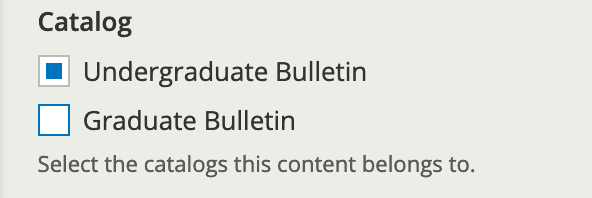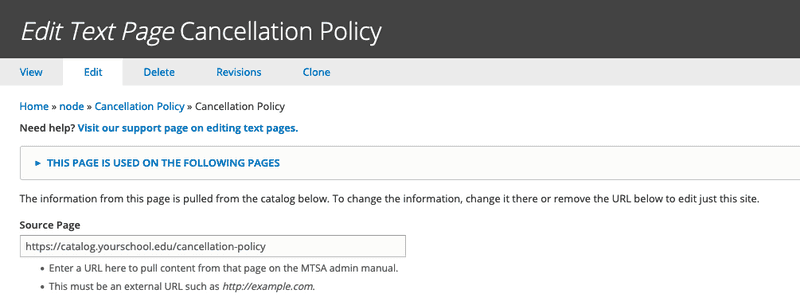Managing Multiple Academic Catalogs
May 26, 2018
Last updated: January 21, 2023
Colleges and universities we work with often need to manage multiple course catalogs. Sometimes it's an undergraduate and a graduate catalog, sometimes it's catalogs spanning a dozen or more different locations. We have a number of different tools to make managing multiple catalogs easier so that work doesn't need to be repeated, so we work with clients to figure out the best options for them. Below are some of the most common scenarios.
Not Sure Which Is Right for You? We'll Help
We've worked with a huge variety of institutions with a lot of different needs — one of the first things we'll do for your buildout is work with you to figure out the best fit for your college or university.
Option 1: Managing Multiple Course Catalogs from the Same Site
One of our most popular setups is to allow colleges and universities to manage multiple catalogs from the same site. In this setup, all content is managed in the same place, but editors indicate which catalog it belongs to.
For an example of this, see the undergraduate and graduate catalogs for Southwestern Adventist University. Both catalogs are managed from the same system, but on the front end are presented as separate sites at their own URLs, and have their own PDF documents.
This sort of setup can be extended to manage as many catalogs as you want. If you have multiple locations with some overlap, or separate colleges within your broader university system, they can all be managed from within the same system.
 A simple checkbox setup for sharing a page between two sites. Any changes made to this page will be reflected everywhere the page is used.
A simple checkbox setup for sharing a page between two sites. Any changes made to this page will be reflected everywhere the page is used.
This setup also means that all technical overhead — user management, workflow configuration, etc. — is shared, and doesn't need to be adjusted for each individual site.
This Is Usually the Right Option If...
- The same team will be working on all catalogs
- Some content will be shared between catalogs
- There won't be large technical or organizational differences between catalogs.
Option 2: Managing Course Catalogs as Separate Sites
Typically we use this option when the two catalogs won't share users or content. As separate sites, it means that any content or user information remains on separate sites. For example, if you change the "Mission" page on one site, it won't change on the other, and likewise with any changes to user information.
Universities often use this option when the two catalogs are totally separate documents run by separate teams, like Villanova University's Undergraduate Catalog and Graduate Catalog. Catalogs can still share branding elements (but don't have to), but most other elements will remain on their separate sites.
This sort of setup gives you flexibility between sites if you want to have one behind a password and another public, or if you want to have substantial differences in how workflows or users are configured.
This Is Usually the Right Option If...
- Different teams are working on different catalogs
- Content isn't shared between catalogs
- There are substantial technical differences between catalogs
Option 3: Managing Course Catalogs as Separate Sites, But Sharing Content
We don't recommend this option often, but occassionally it's the right call. We have functionality where sites can share content but have no other shared functionality.
 A simple setup for sharing a page from another catalog instance. To make changes to this page, the admin would have to adjust the source page it's pulling from.
A simple setup for sharing a page from another catalog instance. To make changes to this page, the admin would have to adjust the source page it's pulling from.
This Is Usually the Right Option If...
- Sites will share content but have substantial technical differences like password protection, workflows, or completely separate admin users.
...Or a Custom Setup
If none of these are the right fit for your institution, we can work with you to figure out something that is — we love getting feature requests.
